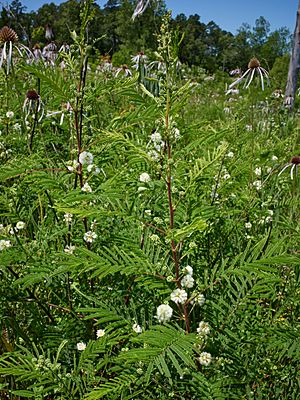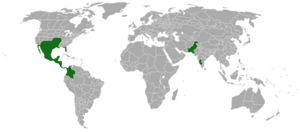Prairie acacia facts for kids
Quick facts for kids Prairie acacia |
|
|---|---|
 |
|
| Conservation status | |
| Scientific classification | |
| Varieties | |
|
|
 |
|
| Range of Acaciella angustissima | |
| Synonyms | |
|
Acaciella angustissima is a special plant known by common names like prairie acacia or white ball acacia. It's super good at handling dry weather and can be used to make soil healthier or cover the ground. This plant is a perennial, which means it lives for more than two years. It's also deciduous, so it loses its leaves every season.
Acaciella angustissima belongs to the Fabaceae family, which includes beans and peas. It starts as a shrub (a bushy plant) and can grow into a small tree. It has lots of leaves and small, white, ball-shaped flowers. After flowering, it grows seed pods that are about 4–7 cm long.
You can find Acaciella angustissima in warm, tropical places near the equator. It needs a good amount of water, usually between 750 to 2,500 mm of rain each year. Even during long dry spells, it keeps its leaves, which is a big advantage. Because it has so many leaves and drops most of them each season, it's great for composting. These fallen leaves can also be used as a small part of livestock feed, but not as the main food source.
Contents
What Acaciella angustissima Looks Like
Acaciella angustissima usually grows as a shrub, but it can also look like a small tree when it's fully grown. Its height can be anywhere from 2 to 7 meters, depending on where it's growing.
The plant's branches are covered with many small, white flowers that grow in clumps. Each flower has five petals and lots of long stamens (the parts that hold pollen) that stick out far past the petals.
After the flowers, the plant produces small seed pods. They start green and turn brown when they are ready. These pods are usually 4–7 cm long and about 6–8 mm wide. The leaves are one of the plant's most interesting features. They are made up of 10–20 pairs of long, thin leaflets arranged along a stem. These pairs of leaflets come in groups of 3–12. Unlike many plants in the Acacia family (which this plant used to be part of), Acaciella angustissima does not have thorns, which makes it quite unique!
Where Acaciella angustissima Comes From
Acaciella angustissima is part of the Fabaceae plant family. It naturally grows in very wet parts of the world, mostly around the equator, because it needs a lot of water. It is native to the southern parts of North America, the Caribbean islands, and most of South America.
This plant can grow at almost any elevation, from sea level up to 2600 meters high. It prefers warm weather, usually between 25–30 degrees Celsius. Even though it's a useful plant, Acaciella angustissima is still not widely used or studied. However, there is hope! About 20 years ago, scientists started looking into it more in tropical areas like Zimbabwe.
Natural Home of Acaciella angustissima
Here are some facts about where Acaciella angustissima naturally grows:
- Altitude: It can grow from sea level up to 2600 meters high.
- Annual Temperature: It likes temperatures between 5 and 30 degrees Celsius.
- Annual Rainfall: It needs a good amount of rain, typically between 895 and 2870 mm per year.
- Soil: Acaciella angustissima grows well in acidic soils that don't have many nutrients. It's also very good at resisting drought (long periods without rain).
How to Grow Acaciella angustissima
Since Acaciella angustissima is a shrub, it can be grown from its seeds or from cuttings. The seeds come from the pods that the plant produces each year. If you want to use cuttings, you should take them from a somewhat firm branch so they can stand up well when planted.
The best time to plant Acaciella angustissima is in March or April. It needs soil that drains water well and is a bit acidic. One of the best ways to use this plant is to prevent erosion (when soil washes away), because it has a very large root system that holds the soil in place.
However, this large root system can also be a problem. If you plant Acaciella angustissima too close to other plants, its roots might compete for important nutrients. Luckily, its fallen leaves can help! They provide enough nitrogen (N), potassium (K), and phosphorus (P) to keep smaller nearby plants healthy. The bushy branches also offer some shade.
Acaciella angustissima can grow on its own without much help and doesn't usually need fertilizer. But, it does grow even better if you add some fertilizer. Remember, it needs a lot of water! It requires at least 700 mm of rainfall but can handle up to 3,000 mm.
Uses of Acaciella angustissima
Making Drinks
The bark of Acaciella angustissima is used to make alcoholic drinks. In Mexico, the root of the plant is used to make a traditional drink called pulque.
Animal Feed
The seeds of Acaciella angustissima are high in protein and can be used as feed for livestock (farm animals). However, the tree contains something called tannin (about 6%). Tannins can make it harder for animals to digest and use the protein from the plant.
Traditional Medicine
The Tzotzil and Tzeltal Maya people in Mexico have traditionally used A. angustissima to help with problems in the digestive system. They also use it to treat toothache, rheumatoid arthritis (a type of joint pain), and cuts on the skin. Scientific studies have shown that A. angustissima can slightly slow down the growth of certain bacteria, like Escherichia coli and Staphylococcus aureus.
Challenges for Wider Use
There are a few reasons why Acaciella angustissima isn't used more widely. First, it needs a lot of water—about 3 to 4 times more rainfall than many drier parts of Africa receive. This is a shame because farmers in dry areas could benefit a lot from this plant.
Second, and very important, Acaciella angustissima can spread very quickly and act like a weed in its natural environment. It's so good at growing and spreading that it can take over.
Third, the plant contains about 10% tannins. Tannins are the plant's natural way of protecting itself. They can make the plant taste unpleasant, and in large amounts, they can negatively affect the digestive systems of livestock.
Important Things to Know
The most important thing to remember about Acaciella angustissima is that it has become a weed in some places where it naturally grows. Because of this, it should only be planted in controlled areas or when it's absolutely necessary.
It's a good choice when you're dealing with very tough conditions where only strong plants can survive, and you need something to cover the ground to help stop erosion. If these conditions are true, you should consider how tall the plant will grow to avoid overcrowding.
Planting other crops between Acaciella angustissima (called intercropping) can be helpful. This allows farmers to use the empty space between the plants, take advantage of the plant's ability to add nitrogen to the soil, and benefit from the shade its bushy branches provide.
Because the leaves have a complex structure, it can take up to a year for them to break down and release their nutrients into the soil. If you want to save seeds, it's important to remove all the seeds from their pods and clean them before storing. This prevents the pods from breaking down and attracting insects.
Images for kids
See also
 In Spanish: Acaciella angustissima para niños
In Spanish: Acaciella angustissima para niños






